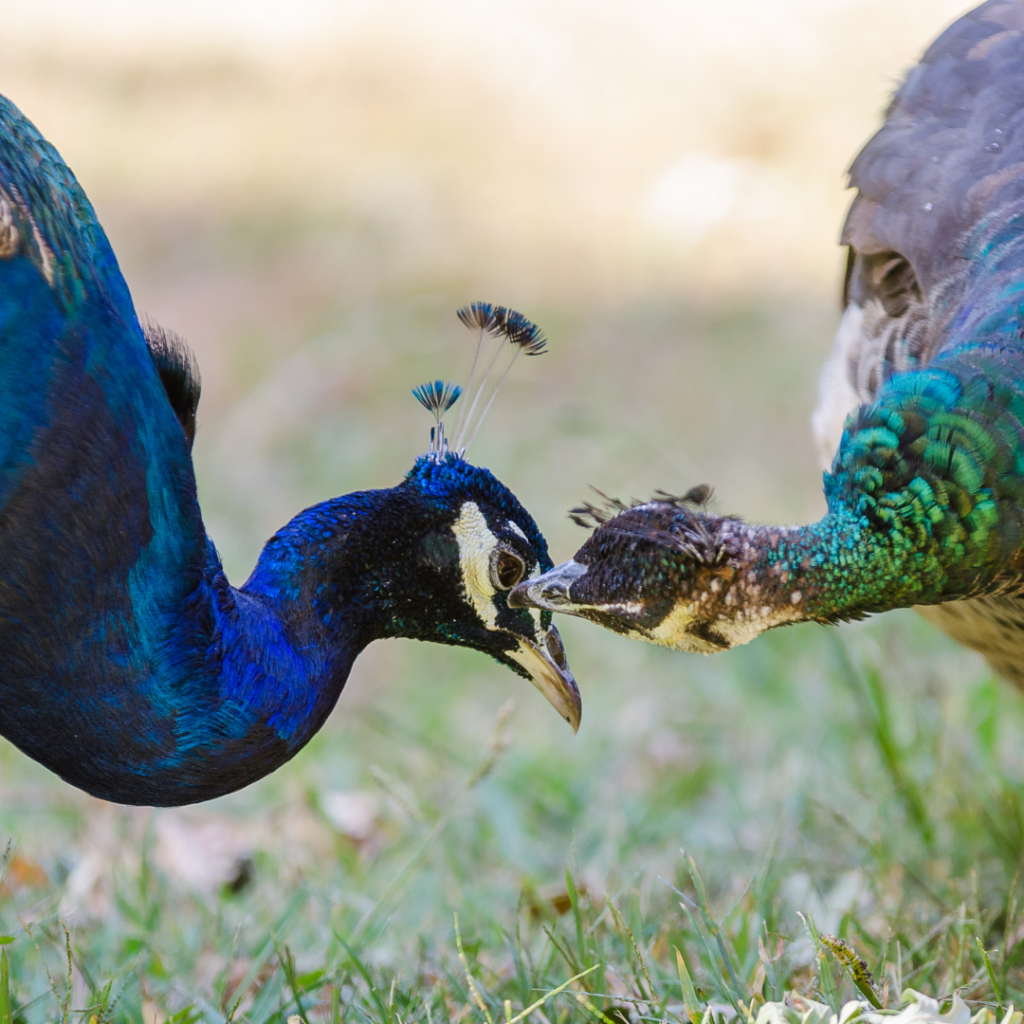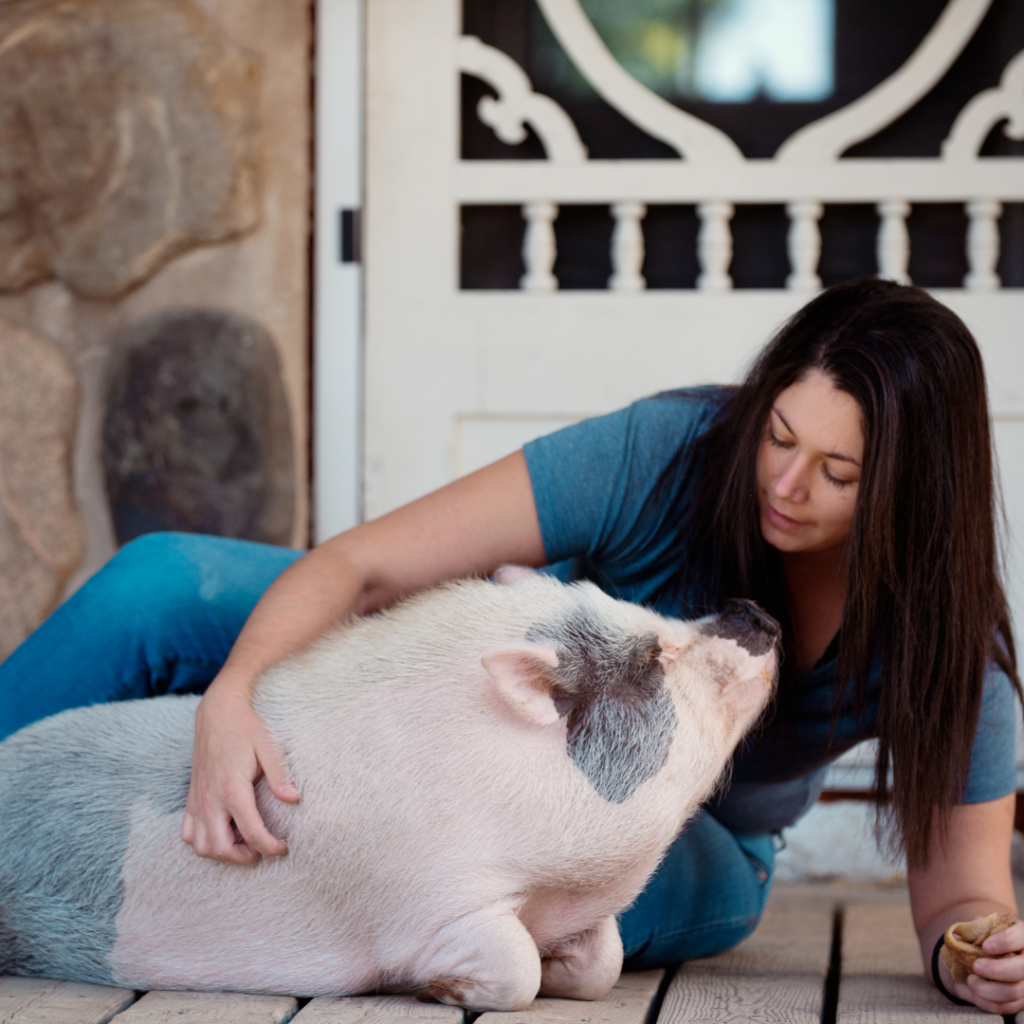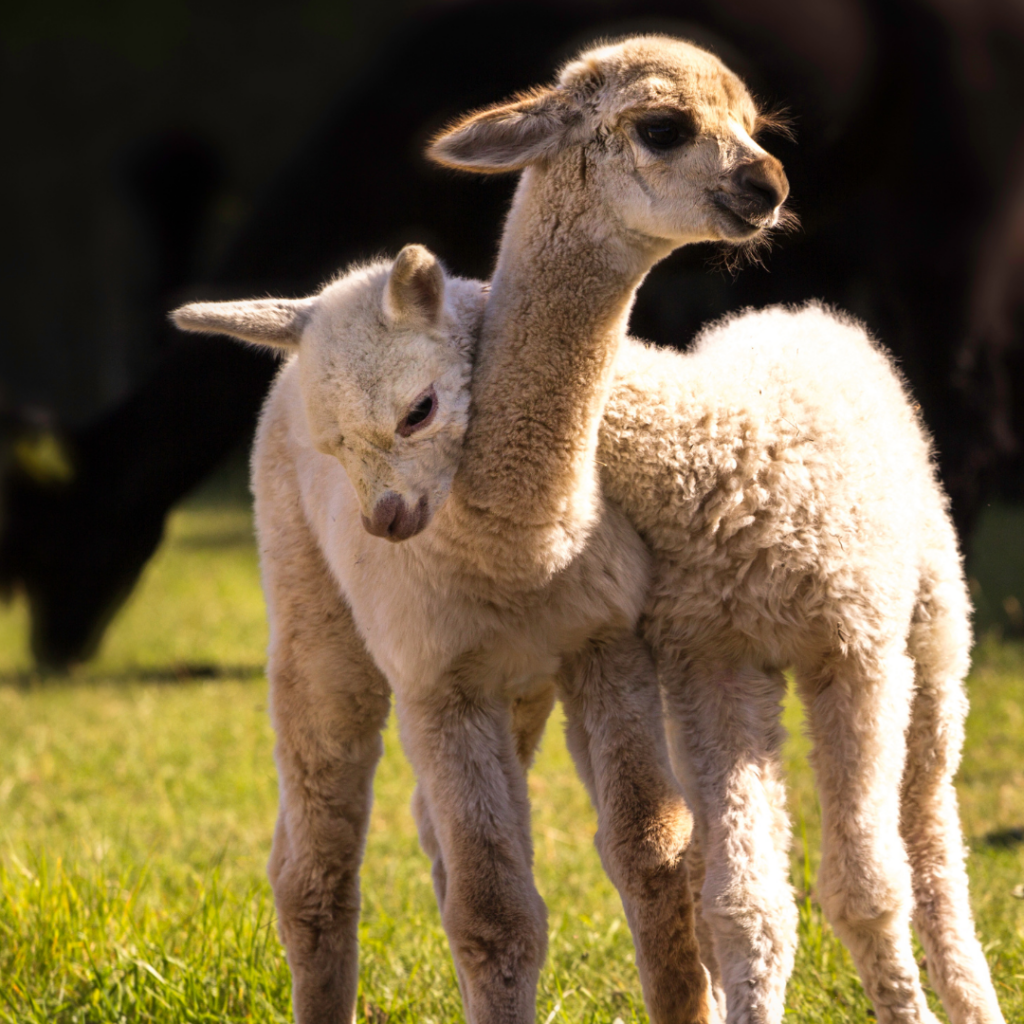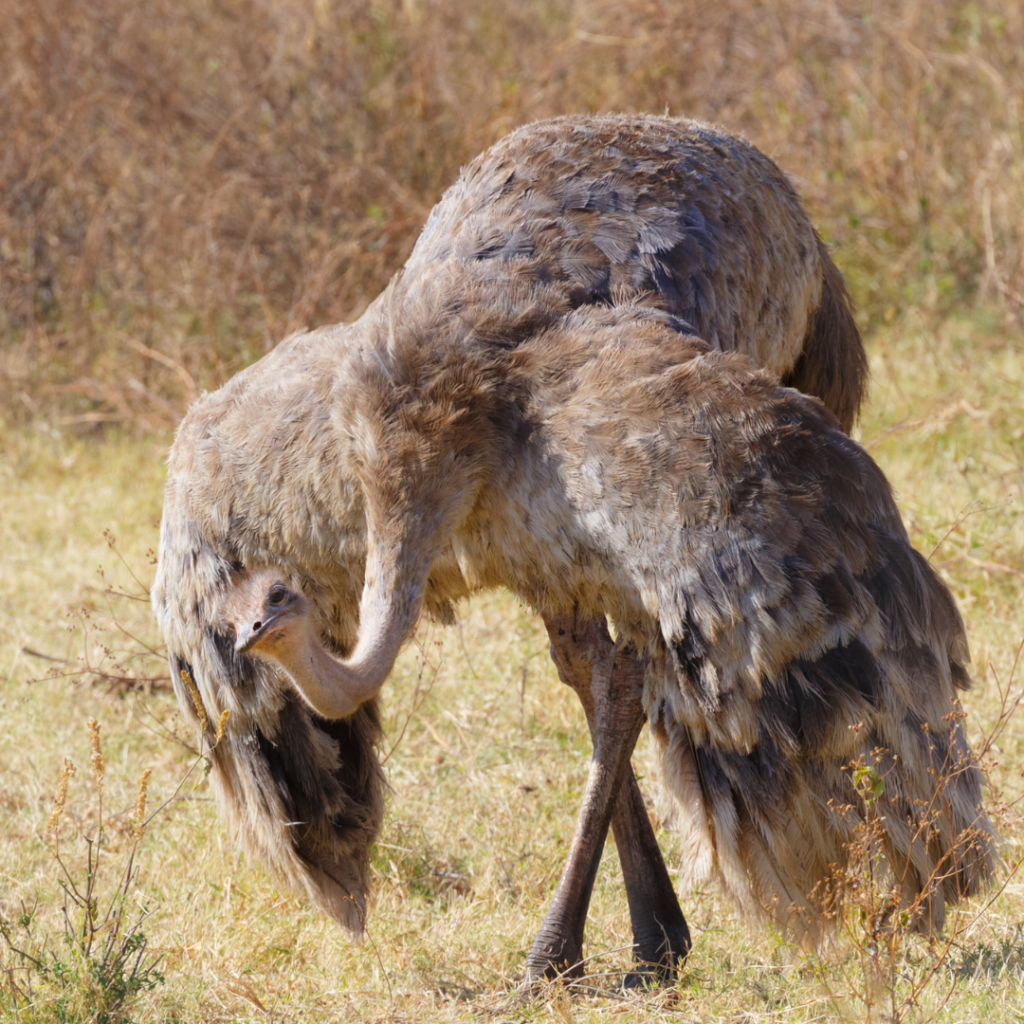
Welcome to another resource in our behavior series! We are excited about this one as we will be delving into the topic of animal communication. Animals communicate to warn of threats, find a mate, care for the young, strengthen bonds, find food, and more. Understanding how animals communicate will help you level up as a caregiverSomeone who provides daily care, specifically for animal residents at an animal sanctuary, shelter, or rescue. at your animal sanctuary. It can help you better appreciate the vocalizations you hear, the behaviors you see, and the body language you observe. While much of communication is intra-species, inter-species communication also exists, as we will see. In this resource, we will touch on 4 types of animal communication and provide examples of each in various species.
Animal Communication
Animal communication is carried out in 6 ways: auditory communication, tactile communication, visual communication (behaviors or body language you can see), chemical communication involving pheromones, electrical communication, and vibrational communication. Various species may rely more heavily on some forms of communication than others. In this resource, we will cover the first four types of communication as the other two, electrocommunication (mostly certain fishes) and vibrational communication (think of touching a spider’s web), are much rarer and generally used by fewer species as a form of communication.
Species-specific communication can be affected by the size, age, reproductive status, sex, proximity to others of their species, the safety of surroundings, and who they communicate with or “at.” If they are communicating with another species other than their own, some domesticatedAdapted over time (as by selective breeding) from a wild or natural state to life in close association with and to the benefit of humans animals can adjust their communication based on what they have observed from the other species’ form of communication. Let’s look closer at each of the four types of communication, starting with auditory communication.
Auditory Communication
Auditory communication is one way many species communicate. All the “noises” you hear from residents help communicate something. A contented grunt/sigh after a nice meal and settling down for a Sun nap, a loud squawk warning the flock of a potential threat, even a squeal from an equine buddy whose breakfast is overdue! All these and more are examples of auditory communication. As I stepped outside this morning, a chorus of bird songs greeted me. They all had plenty to say. Scientists have also recently discovered that many fish species have used auditory communication! Some fishes use their swim bladder to make vibrations other fishesWhile "fish" is often used to refer to multiple fishes, we use "fishes" to underscore that each fish should be considered as an individual with their own needs, preferences, and abilities, rather than as a monolith consisting of thousands of different species. can hear. Others vibrate muscles or move their jaws to communicate.
Check out the BBC Earth Unplugged video and Open Sanctuary Project resources below for examples of the range of auditory communications in these species.
Learn about the plethora of horse auditory communications here: Glossary Of Horse Vocalizations And Sounds | Open Sanctuary Project
Hear camelid (llama and alpaca) auditory communication here: What’s The Word?: A Glossary Of Camelid Vocalizations And Sounds | Open Sanctuary Project
Tactile Communication
Tactile communication is another form of communication. One of my favorite examples is allogrooming. Allogrooming is when two or more individuals of the same species groom one another. This can strengthen bonds and indicate friendship or familial status in some species. Play is also a form of tactile communication that involves body language and even certain vocalizations that ensure everyone is on the same page and that this is play, not confrontationalBehaviors such as chasing, cornering, biting, kicking, problematic mounting, or otherwise engaging in consistent behavior that may cause mental or physical discomfort or injury to another individual, or using these behaviors to block an individual's access to resources such as food, water, shade, shelter, or other residents. behaviors. Other types of tactile communication include a mother licking their young, certain types of posturing in confrontational situations or fighting, and touch related to the reproductive process. Sometimes tactile communication is seen between species. Think of a cat rubbing against your leg or a sheep resident laying their head in your lap while they nap (also see chemical communication below).






Visual Communication
Mating rituals, such as elaborate courtship dances and brightly colored plumage displays, are a great example of visual communication. Body language can also communicate alertness, alarm, excitement, depression, illness, discomfort, contentment, playfulness, appeasement, threats, and more. Body language is a big part of communication within many species. A llama resident with their ears back and their head tilted back generally indicates displeasure. A foal may lift their lips and make a chomping motion with their mouth to appease adults, generally stallions. Reading along with other body postures can provide a pretty clear picture of what is being communicated if you know what to look for. Some communication doesn’t involve behavioral but evolutionary characteristics, such as brightly colored tree frogs, whose vibrant colors warn off predators, indicating danger or death to those who may think to eat them. Another example is shown below. In the bottom left square, you see two images of roosters with their combs apparent. Both combs are erect and red in color. However, one of the combs is turning purplish at the top. This could indicate illness or even a rooster with their sex hormones are high. The context is important. Call your veterinarian if you ever have a doubt about the meaning of a change in a resident’s visual appearance.
Check out our resources on horses and camelid body language!






Chemical Communication
Chemical communication involves pheromones. Pheromones are the chemical signals sent and received by individuals to communicate a variety of information. Chemical communication is so integral to many species that, in recent years, humans have developed synthetic pheromones to help companion cats and dogs adjust to their new home environments and new same-species family members. Many traditionally farmed animal species also communicate with pheromones. These can include pheromones that calm young, help each other identify one another, mark territory, indicate sexual interest and reproductive “readiness,” and indicate where to find food. It’s quite fascinating to see what can be communicated through chemical signals! Pheromones can be found in special scent glands in different species and can be released in various ways. Many ant species drag their abdomen or gastor along their route if they have found food. They release “trail pheromones” that tell others where to go. Male pigs (boars) release sexual hormones in their saliva and may be seen chomping on nothing to produce foamy saliva. The saliva contains two pheromones intended to attract sexually mature female pigs (sows) and plays an important part in courtship and mating. Below, you can see a mother cow with her new calf. Her milk contains pheromones unique to her that will help the calf recognize her even if they get lost in the herd temporarily. Urine is another way in which pheromones are expressed in many species.
In some mammalian species, it is common for a male to sniff a female individual’s urine and vulva in order to ascertain if she is in estrus and likely to be receptive to mating. You may have witnessed the Flehmen response in certain resident species. According to ZooAn organization where animals, either rescued, bought, borrowed, or bred, are kept, typically for the benefit of human visitor interest. And Wild Animal Medicine, “Flehmen is a behavior exhibited primarily by males, occasionally by females, in which the animal raises the nose into the air, with the mouth slightly open, to facilitate pheromone detection by an odor detection organ in the roof of the mouth.”
Pheromones are also released in the feces of various species and can be used to mark territory in addition to other communications.






We hope this resource taught you something fun and helpful about animal communication. Being able to understand better what residents may be trying to convey can result in safer spaces, stronger bonding, healthier residents, and more positive interactions for everyone. Observing residents is also pretty amazing once you have a better idea of how they communicate. Remember, this is just an introductory resource. It is important to research how the species you care for communicate to provide the best care for them.
Infographic
Want a way to easily share and introduce the basics of animal communication with someone? Check out this infographic and spread far and wide!
SOURCES
Evolutionary Patterns In Sound Production Across Fishes | Ichthyology & Herpetology (Non-Compassionate Source)
An Introduction To Animal Communication | Nature Education Knowledge
How Animals Communicate Via Pheromones | American Scientist (Non-Compassionate Source)
Communication Networks | Encyclopedia Of Animal Behavior (Second Edition) (Non-Compassionate Source)
What Are Pheromones And Why Do Animals Use Them? | Science ABC
Trail Pheromones Of Ants | Physiological Entomology (Non-Compassionate Source)
A Love-Dart At The Heart Of Sexual Conflict In Snails | Biomed Central Series Blog (Non-Compassionate Source)
Reproduction Of Ratites | Merck Veterinary Manual (Non-Compassionate Source)
Broom and Fraser’s Domestic Animal Behaviour And Welfare 6th Edition | Donald M. Broom (Non-Compassionate Source)
Principles Of Animal Behavior 4th Edition | Lee Alan Dugatkin (Non-Compassionate Source)
Domestic Animal Behavior For Veterinarians And Animal Scientists 6th Edition | Katherine A Houpt (Non-Compassionate Source)
Non-Compassionate Source? If a source includes the (Non-Compassionate Source) tag, it means that we do not endorse that particular source’s views about animals, even if some of their insights are valuable from a care perspective. See a more detailed explanation here.








